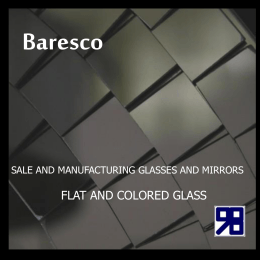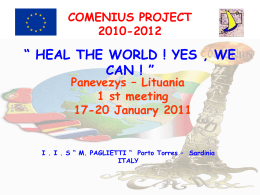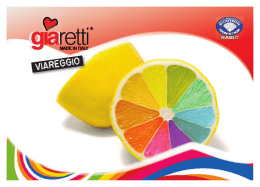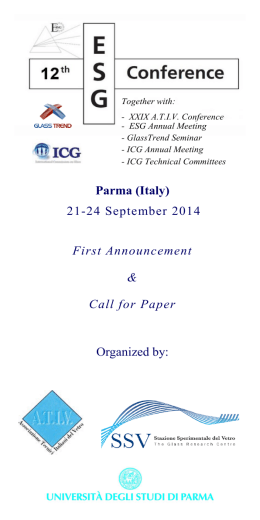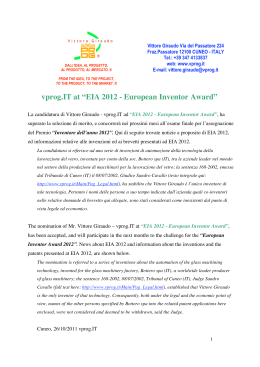4st International Conference on Computational Heat and Mass Transfer Proceedings of 4th ICCHMT May 17–20, 2005, Paris-Cachan, FRANCE ICCHMT’05 - 224 THE ARTISTIC GLASS OF S. DOMENICO’S BASILICA IN PERUGIA: MEASUREMENTS AND SIMULATIONS OF THE MICRO – CLIMATE CONDITIONS Cinzia Buratti* Department of Industrial Engineering, Perugia University 67, Via G. Duranti, 06125 Perugia, Italy R. Mariani Department of Industrial Engineering, Perugia University *Corresponding author: Fax: +39 (0) 75 5853697 Email: [email protected] ABSTRACT INTRODUCTION The works of art preservation is in Italy an argument of great interest, because of its wide historical – artistic heritage. An important role in the preservation is due to the micro – climate conditions, over all for those works of art sensitive to the absolute values and the variations of temperature, solar radiation, relative humidity. Artistic windows, such as the ones in the S. Domenico’s Basilica in Perugia (Italy), are sensitive to these parameters. In the present paper the microclimate conditions in the S. Domenico’s Basilica were measured, in the period January 2003 – June 2004. Data were elaborated and compared with the optimal values of the parameters given by the Italian Standard UNI 10829 and the Risk Index, defined as the percentage of time, during a month, in which the values of each parameter are outside the optimal values range, was calculated. A simulation of the thermal conditions of the artistic glass was finally carried out, employing the Fluent 6.1 software. The Department of Industrial Engineering of the University of Perugia is for long time involved in the study of the preservation conditions of the works of art [1, 2]. In particular, in 1993, the ventilation system of the Arrigo Fiammingo artistic window in the Cathedral of Perugia was designed and built [1]: the micro – climate conditions were investigated and the Risk Indexes, such as defined in the Italian technical Norm UNI 10829 [3], were calculated for the main parameters [4]; then the thermal expansion of the glass was evaluated and the aging influence on the thermal expansion properties was investigated [5, 6]. In the present paper the S. Domenico’s Basilica glass is considered. During this period the glass is under a restoration process. A study, similar to the one of the Arrigo Fiammingo’s glass, was requested by the Superintendence of Environmental, Architectural, Artistic and Historical Works of Art of Umbria, even if the problem is more complex, due to the glass dimensions. In a previous paper [7] the spectral properties of three restored panels of the glass were measured, in order to compare the characteristics of the ancient parts (1400) and of the ones restored in 1800. A preliminary study of the problem is the aim of the present paper. It is divided into two parts. In the first one the thermoigrometrical conditions around the glass, inside and outside the Basilica, were measured in the period January 2003 – June 2004; hourly data were measured and elaborated, in order to characterize the micro – climate conditions. Data were compared with the optimal conditions given by the UNI 10829 [3] and the Risk Index for the glass NOMENCLATURE RI = Risk Index (%); W = solar radiation (W/m2). Subscripts: d = daily; e = external; h = hourly; i = internal; s = surface. Greek Symbols Ф = relative humidity (%); ∆T = temperature variation (K, °C); ∆Ф = relative humidity variation (%). 4st International Conference on Computational Heat and Mass Transfer was evaluated. In the second part a numerical simulation of the surface temperature distribution over the glass was carried out, by means of Fluent 6.1 Software, in order to consider the temperature difference between different points of the glass, the thermal expansion of the glass and the rupture risk [5]. THE ARTISTIC GLASS DOMENICO’S BASILICA OF S. 23 m The artistic glass of S. Domenico’s Basilica was built in 1411; it was realized by Mariotto di Nardo and Bartolomeo di Pietro, who signed the glass at the right bottom part [8]. The glass is a “multiple lanced window” located in the apse chapel, constituted by many single glasses connected each other by a stone structure (see figure 1); the glass is about 8 m wide and 23 m high at the top. 8m Figure 1 The artistic glass of S. Domenico’s Basilica The glass represents the glorification of the Domenican Order: there are at the bottom S. Domenico and S. Pietro, in the central part some Saints and Martires and at the top the S. Giacomo’s life. From 1411 until today the glass was subjected to many restoration processes; very important was the ‘800 restoration, when many damaged panels were substituted. The actual restoration is also very important: the glass panels were removed from the apse chapel and were sent to a restoration laboratory. The glass restoration is now completed; in the meantime the stone structure was also restored and it is ready too. In the next months the collocation of the glass panels in their original position and the design of an external glass protection will be carried out. THE MONITORING SYSTEM A monitoring system was employed to measure the thermoigrometrical conditions around the artistic glass and to compare them with the optimal conditions for its good preservation. The measured parameters were: - internal air temperature Ti; - external air temperature Te; - internal relative humidity Фi; - external relative humidity Фe; - external solar radiation Wi. The measurement period was January 2003 – June 2004; the mentioned parameters were continuously recorded and hourly averaged, as indicated by the Italian Standard UNI 10829 [3], so it was possible to calculate the parameters variation and their medium, maximum and minimum values. The acquisition system was composed by : - a WMR 918 Cable Free Weather Station by Oregon Scientific, for internal and external temperature (precision: ± 0.2°C) and relative humidity measurements (precision: ± 5%), located at about 10 m from the bottom of the glass; - an acquisition system Babuc/M by LSI – Lastem for the solar global radiation measurements (precision: ± 5 W/m2), located in correspondence of the other probes, over a vertical surface parallel to the external surface of the apse chapel; - two thermoigrometers by Salmoiraghi, for the internal temperature (accuracy: ± 0,5˚C) and relative humidity measurements (accuracy: ± 3%), located at the top and at the bottom of the glass. The external temperature probe was screened from the direct solar radiation; all the probes were located so that dusts due to the structural restoration could not cover them. All recorded data were collected weekly and then post-processed. PRESERVATION OPTIMAL CONDITIONS The works of art preservation is influenced by their climatic history, because of the thermoigrometric equilibrium between the work of art and the environmental conditions in which it was put during all its life. So it is very difficult to establish optimal conditions for the preservation; the UNI 10829 gives the optimal values for many kinds of material and works of art, defining absolute values for air temperature and relative humidity and their hourly and daily variations. Optimal values of other parameters such as UV radiation and dose of light are also given, but they are not of interest in the present work. The UNI 10829 gives the following 4st International Conference on Computational Heat and Mass Transfer February Frequency (%) 100 90 80 70 60 50 40 30 20 10 0 Normal Normaldistribution distribution Cumulatedfrequency frequency Cumulated 5 6 7 8 9 10 11 12 13 14 15 16 17 18 19 20 21 22 23 24 Ti (°C) August 100 90 80 70 60 50 40 30 20 10 0 Frequency (%) The hourly values of the parameters above mentioned were measured in the period January 2003 – June 2004. Data elaboration was carried out in compliance with the UNI 10829: temperature and relative humidity data with the statistical methodology of the cumulative average were analyzed, considering the monthly mean values of the parameters at each hour. So the cumulative frequency and the normal distribution for the hourly values and the hourly and daily variations of the following parameters were determined: - internal air temperature; - internal air relative humidity; they are representative of the environment in which the glass is put; so a first evaluation of the Risk Index could be done. As an example, figures 2 and 3 show the normal distribution and the cumulative curves of the mentioned parameters in February 2003 and August 2003, which are the coldest and the hottest months of the monitoring period; the percentage of time during which they are into the optimal ranges is put in evidence and the corresponding Risk Index could be evaluated. Results show that in February: - Ti values are too low with respect to the optimal range; the internal air temperature is always below 19°C (RI = 100%); - ∆Tih values are in the optimal range; - ∆Tid values are higher than 1.5 °C in the 55% of the time (RI = 55%); - Фi values are out of the optimal range in the 96% of the time (RI = 96%); - ∆Фih values are in the optimal range; - ∆Фid values are out of the optimal range in the 50 % of the time (RI = 50%). In August: Normal distribution Normal distribution Cumulated frequency Cumulated frequency 19 20 21 22 23 24 25 26 27 28 29 30 31 32 Ti (°C) 100 90 Frequency (%) DATA ELABORATION AND ANALYSIS - Ti values are too high with respect to the optimal range; the internal air temperature is always upper 24°C (RI = 100%); - ∆Tih values are in the optimal range; - ∆Tid values are higher than 1.5 °C in the 70 % of the time (RI = 70%); - Фi values are out of the optimal range in the 33 % of the time (RI = 33%); - ∆Фih values are in the optimal range; - ∆Фid values are always higher than 6% (RI = 100%). The external air temperature and relative humidity were important to calculate the equilibrium surface temperature of the glass and the relative humidity of the external environment, in order to evaluate the real Risk Index of the glass. 80 70 60 50 40 30 20 10 0 August cumulated August cumulated frequency frequency February cumulated February cumulated frequency frequency 0 0,5 1 100 Frequency (%) values of the optimal parameters for the painted internal surface of the glass: - T = 19 – 24 °C; - ∆Td = 1.5 °C; - ∆Th = 1.5 °C; - Ф = 40 – 55%. No values are given for ∆Фh and ∆Фd, but the glass is painted in the internal side, so values given for paintings could be considered: - ∆Фh = 6%; - ∆Фd = 6%. The UNI 10829 defines the Risk Index RI as the percentage of time, during a month, in which a parameter is out of the optimal range. It could be calculated by a statistical elaboration of the data and employing the frequency cumulative curve of each parameter. 1,5 2 ∆Tih (°C) 2,5 3 90 80 70 60 August cumulated August cumulated frequency frequency February February cumulated cumulated frequency frequency 50 40 30 20 10 0 0 0,5 1 1,5 2 2,5 3 3,5 4 4,5 ∆Tid (°C) 5 5,5 6 6,5 7 7,5 Figure 2 February and August: statistical elaboration of internal temperature data 8 February 100 90 80 70 60 50 40 30 20 10 0 Normal distribution Cumulated frequency Frequency (%) 0 Frequency (%) 20 30 40 100 90 80 70 60 50 40 30 20 10 0 50 Φi (%) August 60 70 80 90 100 Normal distribution Cumulated frequency 0 10 20 30 40 50 Φi (%) 60 70 80 90 January February March April May June July August September October November December January February March April May June 100 100 90 80 70 August cumulated frequency February cumulated frequency 60 50 40 30 20 10 0 0 1 2 3 4 5 6 ∆Φih (%) 100 7 8 9 10 90 80 2004 Frequency (%) 10 - RI associated to Фi is high (> 85%) in January, February, March, April and November, while in the other months it is quite low (< 50%); - RI associated to ∆Фih is always low; - RI associated to ∆Фid is maximum in August (RI = 100%); it is quite high in April, June and July (≈ 70%) and quite low in the other months (< 55%). Values relative to the first six months of 2004 are similar to the ones of 2003, so the obtained values could be considered reliable also for the other months. Table 1 RI values in the period January 2003 – June 2004 2003 Frequency (%) 4st International Conference on Computational Heat and Mass Transfer 70 60 August cumulated August cumulated frequency frequency April cumulated February cumulated frequency frequency 50 40 30 20 10 6 8 10 12 14 16 18 20 22 ∆Tid 18 55 20 62 20 76 81 69 50 56 20 21 14 47 22 65 24 86 Фi 93 96 96 88 42 25 34 33 50 45 96 66 95 100 100 90 42 25 ∆Фih 0 0 0 0 0 0 0 0 1 0 0 0 0 0 0 1 1 0 ∆Фid 50 50 30 72 50 70 70 100 54 63 40 40 50 55 30 75 50 73 90 80 24 ∆Φid (%) Figure 3 February and August: statistical elaboration of internal relative humidity data Data were employed as inputs in the simulation described below. Table 1 and figure 4 show the Risk Indexes in the period of measurement January 2003 June 2004 for the internal air temperature and relative humidity and their hourly and daily variations. The elaborated parameters were compared with the preservation optimal conditions; results show that: - RI associated to Ti is high in all the months, being the internal temperature too high in the hot months and too low in the cold ones with respect to the optimal range; it is relatively low only in September (RI = 18%); - RI associated to ∆Tih is always low; - RI associated to ∆Tid is quite low (< 65%), even if in the hot months (June, July and August) it becomes relevant (> 75%); 70 60 50 40 30 20 Ti ∆Tih ∆Tid Фi ∆Фih ∆Фid 10 0 Ja Fe nua br ry ua M ry ar ch A pr i M l a Ju y ne J S Au uly ep g te us m t O be N cto r ov b D em er ec b em er Ja be r Fe nua br ry ua M ry ar ch A pr il M a Ju y ne 4 RI (%) 2 ∆Tih 0 0 0 0 0 1 1 0 0 1 2 0 0 0 0 0 0 0 100 0 0 Ti 100 100 100 100 62 85 66 100 18 70 100 100 100 100 100 100 68 82 Figure 4 RI trend in the period January 2003 – June 2004 TEMPERATURE DISTRIBUTION ON THE ARTISTIC GLASS: SIMULATION The thermal strain and stress depend on the surface temperature distribution over the artistic glass, so a simulation was carried out employing the Fluent 6.1 software. The micro – climate and sunlight conditions determine the surface temperature distribution; some situations in which thermal stress is more relevant must be chosen, in order to consider the most critical conditions for the glass. So the surface temperature distribution was evaluated in February and August. In February the surface 4st International Conference on Computational Heat and Mass Transfer temperature distribution was calculated at 2.00 a.m., which is the coldest hour of the day. In August the surface temperature distribution was calculated in the hottest hour of the day (13.00 p.m.), when the temperature difference between internal and external air is highest and the solar radiation is at its peak. It is the sum of the direct and diffuse components, calculated from the measured global solar radiation: a value of 390 W/m2 for total solar radiation was considered (308 W/m2 direct fraction and 82 W/m2 diffuse fraction). The geometrical model was first built, composed of a parallelepiped volume (Figure 4), the inner of which represents a part of the Basilica’s volume; the artistic glass is one of the boundary surfaces of the considered volume. The artistic glass was represented as a surface because of its low thickness with respect to the other dimensions, so its internal temperature was considered constant and equivalent to the surface one. 15 14 13 7 8 9 1 2 3 10 11 12 4 5 6 Figure 4 Domain employed in the simulation and zones in which was divided the artistic glass Table 2 Averaged absorption coefficient of the artistic glass for normal incidence and diffuse radiation Zone 1 2 3 4 5 6 7 8 Normal incidence 0.314 0.324 0.315 0.314 0.304 0.313 0.324 0.339 Diffuse radiation 0.261 0.269 0.261 0.260 0.252 0.260 0.269 0.281 Zone 9 10 11 12 13 14 15 Normal incidence 0.328 0.353 0.349 0.353 0.375 0.379 0.387 Diffuse radiation 0.272 0.293 0.290 0.294 0.309 0.311 0.315 The dimensions of the domain employed in the simulation are: depth 20 m, height 23 m and width 8 m. The artistic glass was divided into 15 distinct zones (Figure 4); for each one the mean absorption coefficient of the glass was calculated as the mean of the absorption coefficients of the different colours, wheighed on the area of each surface (table 2). The Fluent software is based on finite volumes [9, 10]; two kinds of mesh were employed: - close mesh, in the 15 zones of the artistic glass; - wide mesh, in the parallelepiped volume. The software also requests the following properties of the materials involved in the model as input data: density, specific heat, thermal conductivity, viscosity. The values in Table 3 were considered. Table 3 Input data in the simulation: material properties Material Air Wall Glass ρ (kg/m3) 1.225 1700 2720 cp (j/kgK) 1006 464 838 K (W/mK) 0.0242 0.65 0.14 µ (kg/ms) 1.789e-5 0 0 To simulate the heat transfer between internal and external air through the artistic glass were activated the following models of Fluent 6.1 [10, 11, 12]: - radiative model DO (Discrete Ordinate), suitable for simulating radiative flows through semi – transparent means; - standard k-ε model, for simulating the turbulent air motion; - Boussinesque model, for simulating the convective motion inside the church. The radiative and convective flows between the glass surface and the external air were considered; an external heat transfer (convection and radiation) coefficient of 23.2 W/m2K was chosen. For the other surfaces of the domain, adiabatic conditions were imposed, so that heat transfer is present only through the artistic glass. Results of the simulation related to August are shown in figure 5. The surface temperature of the artistic glass is quite constant in each one of the 15 zones, except for the zones 13, 14 and 15, where a maximum value of 308 K was found; they are characterized by a higher absorption coefficient. In each zone the temperature decreases near the stone structure and the difference between the most high temperature and the most low is 7 K. The simulation for each hour of February and August mean monthly day was repeated, in order to calculate the Risk Index in Table 4. Results show that RI associated to the surface temperature is very high (RI = 100%) both for August and February; the RI for ∆Th are quite low. The UNI 10829 suggests also the calculation of RI due to the temperature difference between the glass and the internal air; results show that it is quite high (≥ 50%). In the months of February and August, the results confirm a high Risk 4st International Conference on Computational Heat and Mass Transfer Index for the artistic glass, as calculated through the experimental data. 308 K 307 K 306 K 305 K 304 K 303 K 302 K REFERENCES 301 K Figure 5 Temperature distribution on the artistic glass at the 13.00 p.m. of the August monthly mean day Table 4 Risk Index evaluation on the artistic glass In February and August Parameter Ts (°C) ∆Tsh (°C) ∆T internal air - glass (°C) Artistic glass respectively the coldest and the hottest month of the monitoring period, with the most critical conditions for the glass. Results show that the micro – climate conditions near the artistic glass present high Risk Indexes; in February and August the artistic glass surface temperature values are always out of the optimal range (RI = 100%), so this preliminary analysis shows that it is necessary to protect the artistic glass after restoration, in order to decrease its surface temperature. So it could be possible to reduce the damaging risk due to the environmental conditions. Optimal values 19 - 24 1.5 1.5 August 100 12.5 62.5 RI % February 100 5 50 CONCLUSIONS In the present paper the state of preservation of the artistic glass in the apse chapel of S. Domenico’s Basilica in Perugia was analyzed. The micro – climate conditions were monitored in the period January 2003– June 2004 and a thermal analysis of the artistic glass by means of the thermofluidynamic software Fluent 6.1 was carried out. The thermoigrometric measured parameters were compared with the optimal preservation values, in compliance with the UNI 10829. It suggests the calculation of the Risk Index associated to the different measured and simulated parameters, defined as the percentage of time, during a month, in which the values of each parameter and its hourly and daily variations are outside the optimal range. The RI due to Ti is always high (62 ÷ 100%) both in the cold and the hot months, while the one due to Фi is high in the cold and spring months (> 85%). The RI due to the Ti and Фi hourly variations is always low, while the one due to the daily variations is high only in the hot months (> 70%). The Risk Indexes due to the glass surface temperature for February and August were calculated by a simulation; they represent 1. C. Buratti, F. Cotana, M. Felli, Sulla ventilazione di una vetrata artistica nel Duomo di Perugia, 49° Congresso Nazionale ATI, Perugia, 1994 (in Italian). 2. F. Asdrubali, C. Buratti, 1999, Condizioni ottimali di conservazione delle opere d’arte: rassegna bibliografica ed analisi critica, 54° Congresso Nazionale ATI, L’Aquila, 1999 (in Italian). 3. UNI 10829, Beni di interesse storico artistico. Condizioni ambientali di conservazione. Misurazione e analisi, 1999 (in Italian). 4. F. Asdrubali, C. Buratti, F. Cotana, Il sistema di ventilazione della vetrata di Arrigo Fiammingo nel Duomo di Perugia: monitoraggio delle condizioni termoigrometriche, 54° Congresso Nazionale ATI, L’Aquila, settembre 1999 (in Italian). 5. C. Buratti, Analysis of the thermal stress and strain on Arrigo Fiammingo’s artistic window in the Cathedral of Perugia, Journal of Heat Transfer, ASME, Vol. 123, 2001. 6. C. Buratti, Aging influence on the thermal and optical properties of artistic glasses: experimental data and comparison, The 6th ASME-JSME Thermal Engineering Joint Conference, Hawaii, 2003. 7. C. Buratti, F. Asdrubali, R. Mariani, Misura delle proprietà spettrofotometriche di alcuni pannelli restaurati della vetrata di S. Domenico a Perugia, 58˚ Congresso Nazionale ATI, S. Martino di Castrozza, 2003 (in Italian). 8. G. Marchini, Le vetrate dell’Umbria, CVMA Italia, vol. I, Roma, 1973 (in Italian). 9. G. Comini, Fondamenti di termofluidodinamica computazionale, SG Editoriali, Padova, 2001(in Italian). 10. Chima, Yokota, Numerical Analysis of Three Dimensional Viscous Internal Flows, AIAA Journal, 1990. 11. S.V. Patankar, Numerical Heat Transfer and Fluid Flow, McGrow – Hill Book Company, 1990. 12. C. Wilcox, Turbolence Modeling for CFD, DCW Industries, 1998.
Scarica
